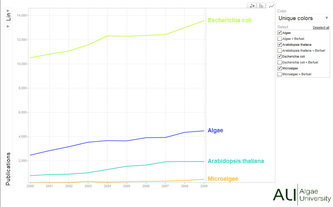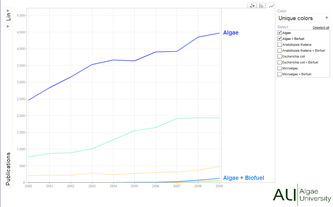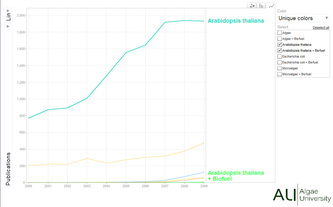It seems like everywhere we turn now there is something about algae. Maybe that is just me, but there is no doubt there is an increase in research publications. There has been an interesting trend in the area of of research models for biofuels. Algae and microalgae for fuel have become incredibly hot research topics especially in biofuels.
Using the database Scopus I searched the terms “algae”, “microalgae”, “Arabidopsis thaliana”, and “Escherichia coli” to find the number of publications for each year. When you look at the number of papers published per year for each term, and each term in relation to biofuel papers you see some interesting results.
Algae, and microalgae publications are exploding! There are more publications related to algae for biofuels than there are for any of the other model systems.
Using the database Scopus I searched the terms “algae”, “microalgae”, “Arabidopsis thaliana”, and “Escherichia coli” to find the number of publications for each year. When you look at the number of papers published per year for each term, and each term in relation to biofuel papers you see some interesting results.
Algae, and microalgae publications are exploding! There are more publications related to algae for biofuels than there are for any of the other model systems.
Now, I admit that the comparisons are not exactly fair since all algae species are bundled together and compared with specific model systems. However, it is likely that with the broad scope of algae that are being studied, a few model systems of algae will emerge for studying biofuels. One potential model system would be Botryococcus braunii which is a well known high oil producer of long chain hydrocarbons.
Publications of algae whose genomes are being sequenced at Joint Genome Institute
The Department of Energy Joint Genome Institute currently has 60 algae genome projects underway with more in the works. Most algae strains whose genomes are being sequenced were selected based on the foundation of literature that is available on them or because of some unique characteristic. This has resulted in the majority of genome projects focused on Chlamydomonas and Chlorella. The graph below shows the number of publications for each strain of algae over the last 50 or so years.
See the video below for a demonstration of viewing the data. Better yet go over to the about algae page and change settings to view the data. Enjoy!
Publications of algae whose genomes are being sequenced at Joint Genome Institute
The Department of Energy Joint Genome Institute currently has 60 algae genome projects underway with more in the works. Most algae strains whose genomes are being sequenced were selected based on the foundation of literature that is available on them or because of some unique characteristic. This has resulted in the majority of genome projects focused on Chlamydomonas and Chlorella. The graph below shows the number of publications for each strain of algae over the last 50 or so years.
See the video below for a demonstration of viewing the data. Better yet go over to the about algae page and change settings to view the data. Enjoy!






 RSS Feed
RSS Feed
